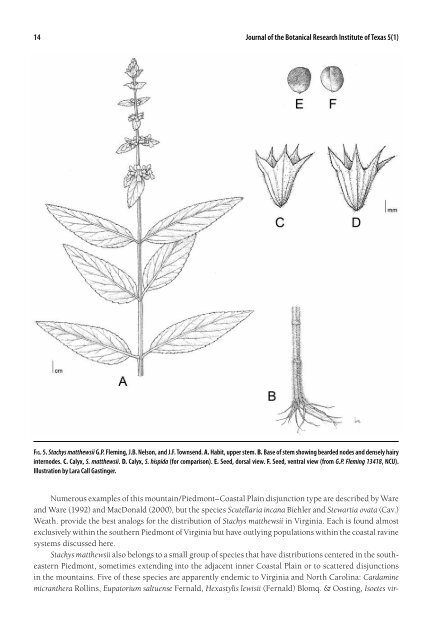(Stachys: Lamiaceae) from the - Botanical Research Institute of Texas
(Stachys: Lamiaceae) from the - Botanical Research Institute of Texas
(Stachys: Lamiaceae) from the - Botanical Research Institute of Texas
Create successful ePaper yourself
Turn your PDF publications into a flip-book with our unique Google optimized e-Paper software.
14 Journal <strong>of</strong> <strong>the</strong> <strong>Botanical</strong> <strong>Research</strong> <strong>Institute</strong> <strong>of</strong> <strong>Texas</strong> 5(1)<br />
Fig. 5. <strong>Stachys</strong> mat<strong>the</strong>wsii G.P. Fleming, J.B. Nelson, and J.F. Townsend. A. Habit, upper stem. B. Base <strong>of</strong> stem showing bearded nodes and densely hairy<br />
internodes. C. Calyx, S. mat<strong>the</strong>wsii. D. Calyx, S. hispida (for comparison). E. Seed, dorsal view. F. Seed, ventral view (<strong>from</strong> G.P. Fleming 13418, NCU).<br />
Illustration by Lara Call Gastinger.<br />
numerous examples <strong>of</strong> this mountain/Piedmont–coastal Plain disjunction type are described by ware<br />
and ware (1992) and macdonald (2000), but <strong>the</strong> species scutellaria incana Biehler and stewartia ovata (cav.)<br />
weath. provide <strong>the</strong> best analogs for <strong>the</strong> distribution <strong>of</strong> stachys mat<strong>the</strong>wsii in Virginia. each is found almost<br />
exclusively within <strong>the</strong> sou<strong>the</strong>rn Piedmont <strong>of</strong> Virginia but have outlying populations within <strong>the</strong> coastal ravine<br />
systems discussed here.<br />
stachys mat<strong>the</strong>wsii also belongs to a small group <strong>of</strong> species that have distributions centered in <strong>the</strong> sou<strong>the</strong>astern<br />
Piedmont, sometimes extending into <strong>the</strong> adjacent inner coastal Plain or to scattered disjunctions<br />
in <strong>the</strong> mountains. five <strong>of</strong> <strong>the</strong>se species are apparently endemic to Virginia and north carolina: Cardamine<br />
micran<strong>the</strong>ra rollins, eupatorium saltuense fernald, hexastylis lewisii (fernald) Blomq. & oosting, Isoetes vir-
















